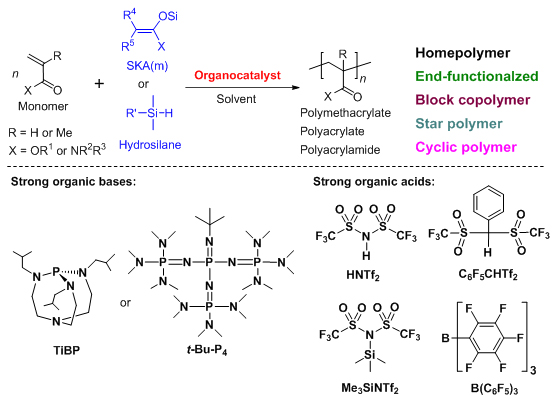摘要/Abstract

基团转移聚合是20世纪80年代继活性阴离子聚合之后由杜邦公司所开发的一种针对丙烯酸衍生类单体的活性聚合方法.其中,丙烯酸衍生类单体主要包括丙烯酸酯、甲基丙烯酸酯、丙烯酰胺及丙烯腈四大类.基团转移聚合中的链引发与链增长基元反应均为向山-迈克尔加成反应.因此,反应原理上而言碱和酸均可成为该聚合反应的催化剂.在有机小分子催化剂被应用于该聚合方法之前,所用的碱为含立体位阻阳离子的可溶性离子化合物,其中亲核性的阴离子起到催化剂的作用;所用的酸为具有路易斯酸性的金属或过渡金属化合物.2007年以来,有机小分子碱和酸逐渐被应用于基团转移聚合的催化剂,并把该类聚合称为有机催化基团转移聚合.相较于以往的基团转移聚合,有机催化基团转移聚合在聚合物分子量及分子量分布控制、可聚单体的范围、聚合物拓扑结构的控制等方面都有了全新的拓展.本综述主要围绕我们近年来在该领域的工作,从有机强碱催化的基团转移聚合、有机强酸催化的基团转移聚合、基于氢硅烷的新型有机催化基团转移聚合以及聚合机理4个方面对有机催化基团转移聚合领域的最新进展进行论述.
关键词: 有机催化, 基团转移聚合, 可聚单体, 分子量及分子量分布, 聚合物拓扑结构
Group transfer polymerization (GTP) is a living polymerization method for acrylic-derived monomers developed by DuPont after living anionic polymerization in the 1980s. The acrylic-derived monomers mainly include acrylate, methacrylate, acrylamide and acrylonitrile. The elementary initiation and propagation reactions in GTP are all rooted in the Mukaiyama-Michael addition reaction. Therefore, in principle both base and acid can sever as the catalyst for GTP. Before the small molecular organocatalyst is applied to the polymerization method, the normally used base has been a soluble ionic compound containing a sterically hindered cation, in which the nucleophilic anion acts as the true catalyst. The normally used acid has been a metal or transition metal compound having Lewis acidity. Since 2007, small organic bases and acids have been gradually used to catalyze GTP, and this type of polymerization has been named as organocatalyzed GTP. Compared with the conventional one, organocatalyzed GTP has made a great improvement in the aspects of molecular weight and molecular weight distribution control of acrylic polymers, scope of polymerizable monomers, topological design of polymer, etc. This review mainly focuses on the author's recent work and will be discussed from four aspects: GTP using organic strong base, GTP using organic strong acid, a novel hydrosilane-based GTP, and polymerization mechanism.
Key words: organocatalysis, group transfer polymerization, polymerizable monomer, molecular weight and molecular weight distribution, polymer topology
PDF全文下载地址:
点我下载PDF
